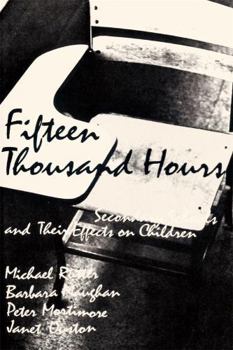Fifteen Thousand Hours: Secondary Schools and Their Effects on Children
Can a good school help its students overcome the adverse effects of economic disadvantage and family adversity? Recent educational assessment suggests that the answer may be a painful no. Here, however, is a book that contradicts the prevailing pessimism about the possibilities of education. In Fifteen Thousand Hours, Michael Rutter and his colleagues show conclusively that schools can make a difference.
In a three-year study of a dozen secondary schools in a large urban area, Rutter's team found that some schools were demonstrably better than others at promoting the academic and social success of their students. Moreover, there were clear and interesting differences between the schools that promote success and the schools that promote failure. As Rutter shows, these differences provide important clues to the kind of educational reform that might allow inner-city schools to act more uniformly as a positive and protective influence on students who must grow up in an otherwise disordered and difficult world. For a dozen years during their formative period of development, children spend as many of their working hours at school as at home--some 15,000 hours in all. To suggest that this tremendous amount of time has no effect on development seems irrational. To settle for schools that simply act as institutions of containment for disadvantaged children seems a strategy of despair. The importance of this major book in education is its clear demonstration that these are not the only alternatives.Format:Paperback
Language:English
ISBN:0674300262
ISBN13:9780674300262
Release Date:March 1982
Publisher:Harvard University Press
Length:296 Pages
Weight:0.75 lbs.
Dimensions:0.9" x 4.9" x 8.3"
Customer Reviews
1 rating
An essential book for unstanding how schools affect behavior
Published by Thriftbooks.com User , 25 years ago
Michael Rutter is a psychiatrist who is a sociologist. It's a rare combination. This particular book is widely cited in the resiiency literature, yet few have read it outside of graduate courses. I knew of the basics of it as a national researcher studying how schools can prevent violence. It wasn't until a few months ago I actually read the book. I wish I had much earlier. Some folks will squawk about the book being written in 1979. It's really timeless. There are powerful lessons to understand in this book. The book sorts out the effects of schools on four domains: achievement, attendance, behavior and delinquency. Each of those domains is studied in the context of inner-city London. Through precision measurement of virtually every aspect of the school environment, Rutter and his colleagues bring us to an understanding of how the smallest of things in a school setting have a large impact, such as the number of student jobs in a building or the amount of student work hung on the walls. The book is shy on describing why these processes work in the way I would like, and I think it's important to turn to the work of people like G.Roy Mayer or Beth Sulzer-Azaroff (Lasting Change)to get a careful understanding of why the processes work. In the age when people are concerned about children shooting others in schools, I think this book is a fundamental book to understand what we must do.





